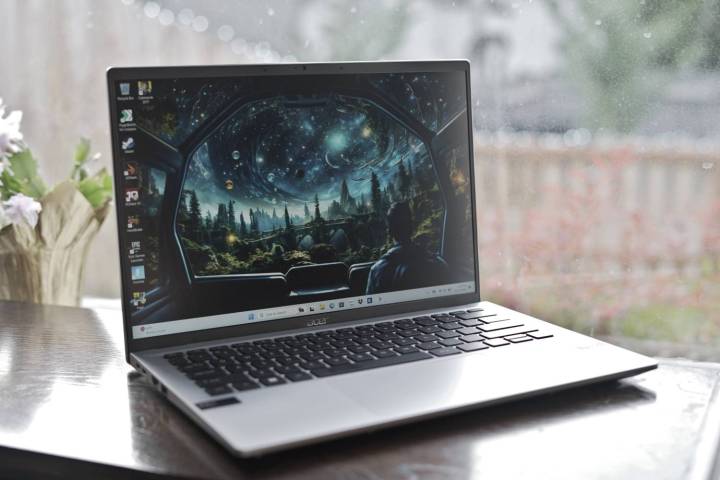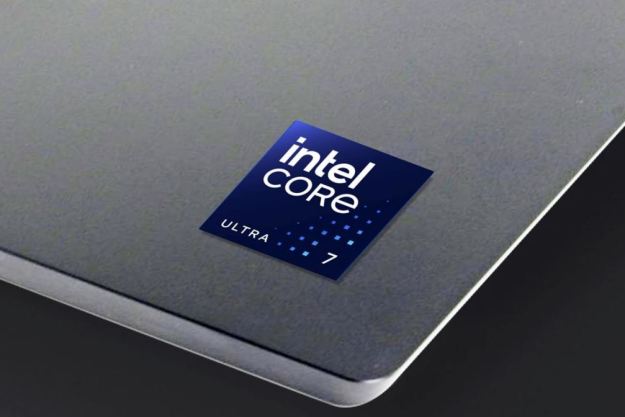
A lot has been made of Intel’s new Meteor Lake chips. They have a new brand, naming scheme, and even new technology in the form of the NPU (neural processing unit).
And they come at an important time. The stakes have never been higher for Intel, as it faces competition from all sides. They’re also an important litmus test for the idea of the NPU, or neural processing unit.
But these are mobile chips, so what ultimately matters is how they perform in laptops you can actually buy. I tested out the Acer Swift Go 14, which came equipped with the Intel Core Ultra 7 155H. While the improvements in integrated graphics are impressive, the overall year-over-year performance has left me scratching my head.
A generational problem

I’ll admit that my review unit wasn’t the most premium of laptops. The Acer Swift Go 14 goes for $1,000, and it’s a relatively unassuming little laptop. It’s made of plastic, has some thick plastic bezels around the screen, and a lackluster trackpad. There’s more coming in a full review of this laptop, but the point for now is to evaluate it as a vehicle for Intel’s new Meteor Lake chips.
The Core Ultra 7 155H chip is what comes inside, and without getting into all the details of the Core Ultra launch, I’ll hit the important specs here — namely that it has 16 cores and 22 threads, with six performance cores and eight efficiency cores, meaning the two extra are something Intel calls low-power efficiency cores.
It also has a base frequency of 3.80GHz. Importantly, the chip runs at a base power of 28 watts rather than 45 watts. In previous years, the “H” in the name would designate a higher-powered 45-watt processor. That’s an important distinction to make, as the previous version of this laptop (which is identical in almost every way) had options for either the 28-watt Core i7-1360P or the 45-watt Core i7-13700H. Our review unit of the previous version had the Core i7-13700H, unfortunately, which isn’t as fair for an apples-to-apples comparison.
While I didn’t have a Swift Go 14 with a Core i7-1360P on hand, I did have some other laptops that should show approximately where the new Core Ultra chips stack up.
I turned to Geekbench 5 and Cinebench R23 first. I used old versions of the benchmarks to get a comparison with the previous generation, and the results were a bit concerning. In both single-core tests, the Core i7-13700H is 5% faster. Meanwhile, it’s 15% faster than the Core Ultra 7 155H in multi-core tests. It’s not all bad news in this comparison, though. The Core Ultra 7 155H in the new Swift Go 14 actually beats the previous-gen chip in the same laptop in PCMark 10 across the board. PCMark 10 is a more practical, application-based series of tests, and it’s arguably a more well-rounded look at how a system performs in day-to-day tasks. The 10% year-over-year uplift is good to see, despite it being a lower-powered chip.
| Geekbench 5 single/multi |
Cinebench R23 single/multi | PCMark 10 | |
| Acer Swift Go 14 (Core Ultra 7 155H) |
1533 / 9015 | 1762 / 10773 | 6665 |
| Acer Swift Go 14 (Core i7-1300H) |
1866 / 11061 | 1863 / 12497 | 5996 |
| Lenovo Yoga 9i Gen 8 (Core i7-1360P) |
1843 / 8814 | 1846 / 8779 | 6102 |
| HP Pavilion Plus (Ryzen 7 7840U) |
1819 / 9655 | 1721 / 12234 | 6804 |
Now, it’s more fair to compare the Core Ultra 7 155H to another chip operating in the same power envelope, such as the Core i7-1360P. This is a 28-watt chip from Intel’s previous generation of chips, and we’ve reviewed a host of different laptops with it. The closest thing to the Acer Swift Go 14 in our review history is probably the Lenovo Yoga 9i Gen 8, another 14-inch laptop.
But even there, it’s not the clear performance upgrade you’d hope for in a new generation. The previous-gen Yoga 9i outpaces the Core Ultra 7 Acer Swift Go 14 by 7% in Cinebench R23 single-core. The positive point is that the Meteor Lake chip is 19% faster in multi-core in that comparison, likely thanks to the two extra low-power efficiency cores.
I threw the Ryzen 7 7840U into the mix too, as featured in another 14-inch laptop, the HP Pavilion Plus. AMD’s current-gen 28-watt chip beats the Meteor Lake chip across every test, including PCMark 10. That’s not a good look for Intel, even with the recent flub that is the Ryzen 8040.
Suffice it to say — comparing mobile chips across different laptops is tricky. Even similarly- sized laptops can perform quite differently from machine to machine. There’s also a slightly faster version of this chip that will be available in other laptops, the Core Ultra 7 165H.
I can say one thing for sure, though: the new Core Ultra 7 chips don’t provide a significant jump in CPU performance. That’s disappointing, given how much hype there was behind Meteor Lake. It’s a good thing Intel had a card up its sleeve with the updated integrated graphics.
Intel Arc makes an impression

The best part of my time with Intel’s Meteor Lake chips so far has been the graphics. We’ve officially entered the Intel Arc era of integrated graphics, and it feels like quite an arrival. Opposite of the CPU performance, Meteor Lake’s graphics are a huge leap forward, with over double the performance of the previous generation of integrated graphics. That’s in this configuration, of course, which came with eight Intel Xe GPU cores on board.
In 3DMark Time Spy, the Core Ultra 7 155H is 29% faster than integrated graphics in AMD’s Ryzen 7 7840U with the Radeon 780M graphics (as featured in the HP Pavilion Plus). The comparison against the Core i7-13700H is even stronger, with the 155H scoring 44% faster in Time Spy. The lead in DirectX 11 Fire Strike isn’t quite as large, but the Meteor Lake chip is still 29% ahead.
It’s an even more impressive results against the Yoga 9i Gen 8 with its Core i7-1360P — and mind you, that’s a fairer comparison. Here, the Core Ultra chip is a whopping 59% faster in Time Spy. That’s massive.
| 3DMark Time Spy |
3DMark Fire Strike | |
| Acer Swift Go 14 (Core Ultra 7 155H) |
3611 | 7794 |
| Acer Swift Go 14 (Core i7-1300H) |
2018 | 5546 |
| Lenovo Yoga 9i Gen 8 (Core i7-1360P) |
1504 | 4150 |
| HP Pavilion Plus (Ryzen 7 7840U) |
2562 | 6209 |
I tested out some games too, to see if integrated graphics might finally take the place of entry-level discrete graphics. The results were pretty impressive. I played some Fortnite, and with settings pulled down to Low, I was able to average around 53 frame per second (fps). That’s at the native resolution of 1920 x 1200 and with 3D resolution at 75%. Fortnite doesn’t look gorgeous at that level, but it wasn’t as horrible as you might think. For the first time (except on the recent MacBooks), you can play a casual, fast-paced game like Fortnite without the need for discrete graphics. That’s a huge win.
Of course, I had to take things one step further to see just how far the Meteor Lake graphics could go. So, I loaded up Cyberpunk 2077 to see if I could get some decent frame rates on one of the more demanding PC games out there. I’d hoped I might be able to push it closer to something more playable, but I the best I could do was 43 fps — and it wasn’t pretty. That was with every setting dropped to low, FSR 2.1 cranked up to ultra performance, and the system performance mode on.
So, no, we haven’t quite quite arrived at the dream of playing demanding PC games on integrated graphics just yet. But in lighter games, the Core Ultra graphics hold up surprisingly well.
What about AI?
Obviously, everything I’ve talked about so far doesn’t address what Intel wants to claim is the biggest benefit of the Meteor Lake platform. Yes, it’s AI. The NPU featured in this chip does provide a boost to AI processes, especially on laptops without a discrete GPU. Some of the real-life examples provided are AI denoising in Adobe Lightroom or Stable Diffusion image generation in Gimp. These are interesting, and from what we’ve seen demoed, the NPU does enable slightly more accurate and efficient background blur, for example. And yes, I realize that doesn’t sound like the game-changing technology the entire PC industry wants it to be.
There’s more testing to be done here, for sure. The purpose of this initial batch of testing for me was to evaluate the Core Ultra 7 against previous generations and competitors on its own terms. Because let’s be honest — I don’t know that the addition of the NPU is going to mean much for the average laptop buyer. Those who are interested in doing lots of local AI tasks are likely better off springing for a more powerful laptop with stronger discrete graphics.
And that leaves these Core Ultra processors in a bit of precarious position. These were supposed to be the beginning of a new era for Intel, and instead, they don’t seem to have been quite ready for primetime. They won’t be scaling up to full custom desktop chips, and even though the integrated graphics are great, Intel needed a big win here. Facing threats from all sides, including AMD, Apple, and even Qualcomm, these Core Ultra processors don’t feel like the fresh new start they needed to be.
Editors' Recommendations
- Nice try, Intel, but AMD 3D V-Cache chips still win
- Intel just boosted gaming performance by up to 155%
- Intel may have a monster new CPU coming soon
- Intel’s CPUs just got way more confusing
- Why MSI’s leaked gaming handheld might crush its competitors


